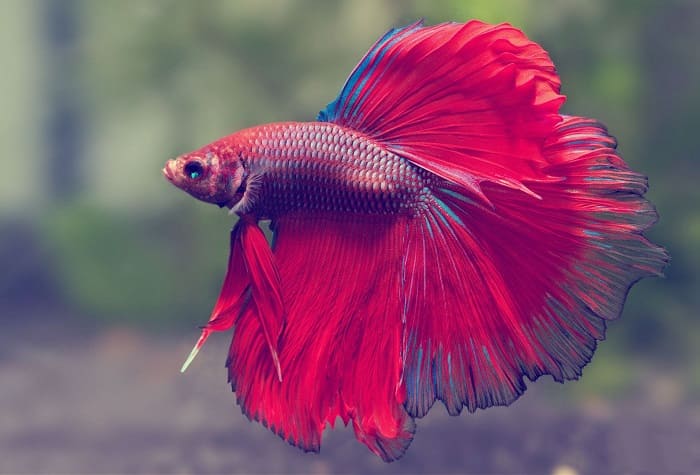Why is my fish fin turning red?
Fin rot is caused by several different types of bacteria, including Aeromonas, Psudomonas and Vibrio, that eat the delicate membranes of the fish’s fin, leaving behind the fin rays. The frayed, damaged tissue is then susceptible to secondary fungal infections, which exacerbate the sickness.

Why does betta fish change color?
Betta fish are very sensitive to their surroundings, and even small changes can cause them stress. This stress can lead to a change in coloration. For example, if you move your Betta to a new tank, they may change color as they adjust to their new home.
Sick Betta Fish Behavior:
- Lethargic: Inactive, lazy, lacks aggression, hiding.
- Refusal to eat for extended periods of time (e.g. days)
- Faded colors, mainly in male bettas.
- Labored breathing.
- Damaged fins.
- Clamped fins.
What does a stressed betta fish look like?
Strange Swimming: When fish are stressed, they often develop odd swimming patterns. If your fish is swimming frantically without going anywhere, crashing at the bottom of his tank, rubbing himself on gravel or rocks, or locking his fins at his side, he may be experiencing significant stress.
What happens when a fish tail is red?
Bloody streaks / red spots in tail or fins: This is a sure sign of a serious problem with the water. High ammonia or nitrites can cause blood hemorrhaging (broken blood vessels) of the veins in the tail of the goldfish, resulting in thin red lines or spots of blood appearing in the fins.
If you suspect that your fish may be suffering from fin rot, take a close look at their fins and tail for the following symptoms:
- Fins or tail appear to have frayed edges.
- The fin or tail edges have turned white, or even black and brown in some cases.
- Inflammation at the base of the fin.
Why are my fish turning red?
Ammonia Poisoning
Ammonia poisoning occurs when the nitrogen cycle (establishment of beneficial bacteria) in an aquarium has not been grown properly or if this cycle has been broken in an aquarium. This can cause the ammonia levels to spike and burn your fish, causing red streaks and dots to appear on your goldfish.
How do you treat red gills in fish?
Symptoms include red or purple gills and/or fish gasping for breath at the water surface. The ammonia level can be reduced by a neutralizer and by a 50% water change. To prevent this from occurring, stock your tank slowly, do not overfeed, remove uneaten food, and change water regularly.
What does fin rot look like on fish?
If you suspect that your fish may be suffering from fin rot, take a close look at their fins and tail for the following symptoms: Fins or tail appear to have frayed edges. The fin or tail edges have turned white, or even black and brown in some cases. Inflammation at the base of the fin.
Why has my fish turned red?
Red pest causes blood red spots or patches on the fish’s body. Red pest disease or pond pest as it is also known is caused by a bacterial infection (bacterium cyprinicida). The disease causes blood red spots or patches to appear on the body of the Goldfish.
Why are my fish turning red and dying?
Red or Purple Gills and Bloody Patches
The fish’s gills will take on a red or lilac color, making them look like it’s bleeding. As the problem progresses, the fish’s tissues will begin to deteriorate, evidenced by red streaks or bloody patches on their body and fins caused by ammonia burns.
Can a fish recover from ammonia poisoning?
Prognosis for Fish with Ammonia Burns
If fish do not suffer severe bacterial infections following ammonia burns, then they usually recover well and can be reintroduced into the tank within a week. Fish with advanced infections or those that are exposed to rapid rises in ammonia levels may die.
Why does it look like my fish is bleeding?
From what I assume, most likely ammonia poisoning. Symptoms include: Gasping for air at the water’s surface. Gills are a red or lilac color, making this fish look like they are bleeding.
What does it mean when your fish is red?
Hemorrhagic Septicemia, also known as Red Pest due to the distinct red streaks that appear on your fish. If the bacteria enters you fish’s circulatory system it will travel throughout, causing damage to body tissue, blood vessels, and the heart. Often resulting in internal bleeding.
Is My Fish Sick?
- Tattered fins, tail. Skin sores. Swollen abdomen.
- Fuzzy spots on skin, mouth. Bacterial infection (Flavobacterium)
- Bumpy growths on skin, fins. Carp Pox.
- White “pimples” on skin, fins. Viral infection (Lymphocystis)
- Cotton-like “hair” on fish, eggs, uneaten food. Water Mold.
- Increased gill movements.
What are signs that my fish is dying?
Loss of appetite. Weakness or listlessness. Loss of balance or buoyancy control, floating upside down, or ‘sitting’ on the tank floor (most fish are normally only slightly negatively-buoyant and it takes little effort to maintain position in the water column) Erratic/spiral swimming or shimmying.